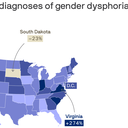Gender dysphoria diagnoses are rising nationwide

Gender dysphoria diagnoses rose in nearly every U.S. state between 2018 and 2022, per a new Definitive Healthcare report.
- They fell only in South Dakota, which last year became the sixth state to restrict gender-affirming care for minors.
Why it matters: The nearly nationwide increases suggest growing demand for gender-affirming care, even amid efforts in many states to restrict access.
Be smart: Gender dysphoria is a form of psychological distress felt by people who believe their assigned sex fails to match their gender identity.
- Not all transgender people experience or are diagnosed with gender dysphoria.
- But such a diagnosis is often a first step when seeking gender-related mental health care or gender-affirming care, in order to access treatment and activate insurance coverage.
State of play: Conservative leaders and lawmakers nationwide have been seeking to restrict gender-affirming care in recent years — in some cases forcing those seeking such care to travel out-of-state to receive it.
- However, not all those who want such care have the means to travel.
- Research shows that access to gender-affirming care can decrease rates of depression and suicide, while transgender advocates say that promotion of gender-affirming care bans can fuel discrimination and hate crimes.
Zoom in: Virginia (+274%), Indiana (+247%) and Utah (+193%) have seen the greatest increases in gender dysphoria diagnoses, while South Dakota (-23%), Hawai'i (+6%) and Connecticut (+10%) have seen the biggest drop or lowest increases, based on medical procedure and diagnosis claims data.
- While South Dakota's ban wasn't enacted until 2023, lawmakers there attempted to pass a similar law back in 2020 — which likely had "the dual chilling effects of reduced access to sympathetic providers and the self-directed seeking of care in states where long-term access was protected," per Definitive Healthcare's report.
What they're saying: "Other states with bans on gender-affirming care for youth have seen year-to-year dips in gender dysphoria diagnoses, too," the report found, "possibly indicating that shifting social and political climates have pushed young patients and their parents to seek diagnoses in states that are friendlier to trans people."
What's happening: It appears that young Americans are increasingly open to seeking gender-affirming care.
- The share of gender dysphoria diagnoses among patients under 18 increased from 17.5% to 20.4% between 2018 and 2022 — perhaps a reflection of trans identities and gender identity ideas becoming "more accepted by society," as the report put it.
Of note: Gender-affirming care is supported by major medical associations, and the transgender population remains relatively small — about 1.6 million people 13 and over, per one estimate, or about 0.5% of the total U.S. population.
The bottom line: While gender dysphoria diagnoses are generally increasing, receiving one is only an early step on many transgender Americans' physical and mental health care journeys.
- What comes next continues to depend heavily on where they live and what resources are available to them.
Go deeper: Most LGBTQ+ adults feel less safe as laws ban gender-affirming care